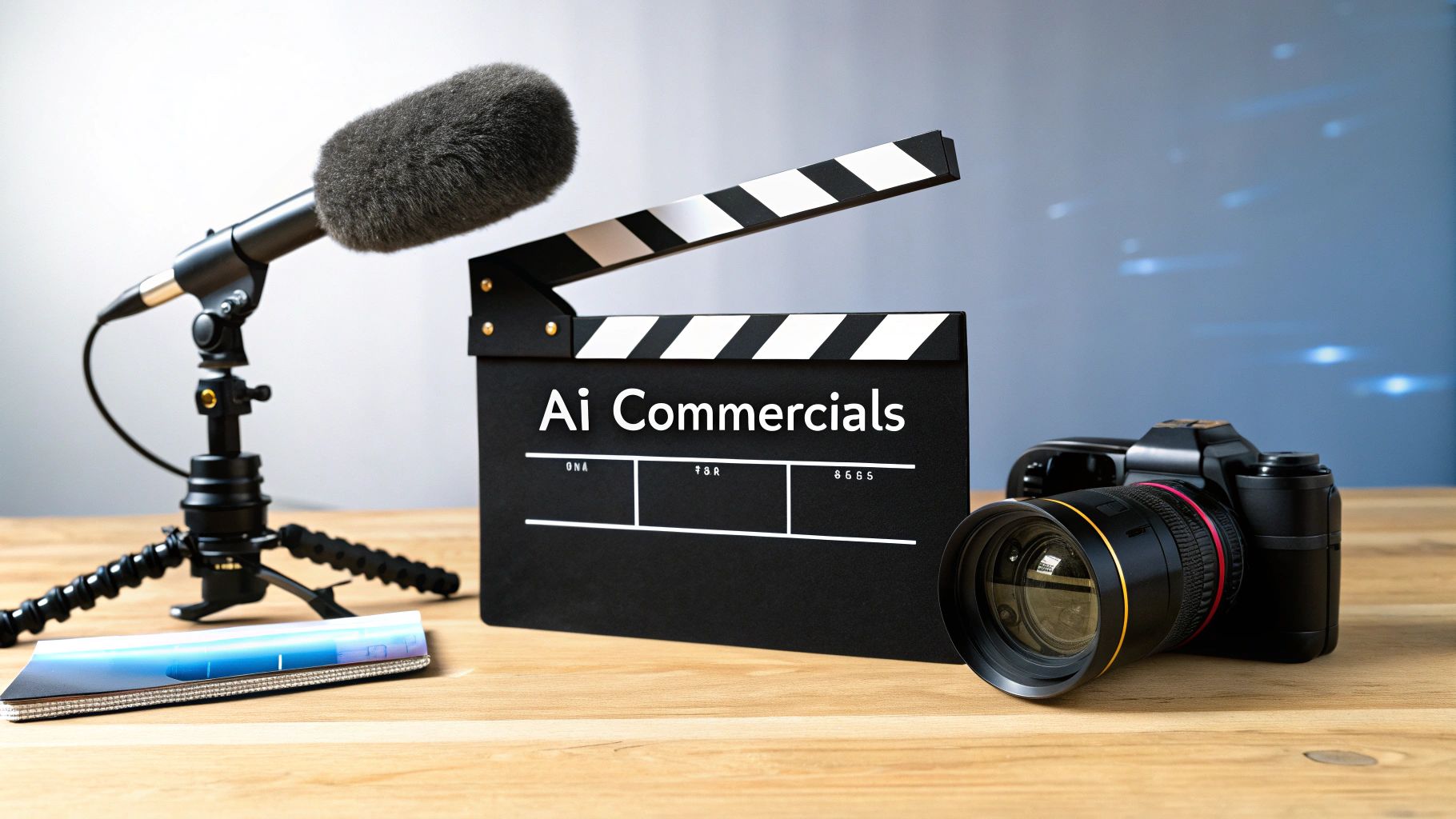
AI Generated Commercials A Modern Guide
Discover how AI generated commercials are changing advertising. This guide explores the tools, benefits, and strategies you need to create effective ads.
Let's be honest, the term "AI-generated commercial" sounds like something out of a sci-fi movie. But it's not a far-off concept anymore; it's a practical tool that brands are using right now.
So, what are we actually talking about? At its core, an AI-generated commercial is a video ad created with the help of artificial intelligence. AI takes on the heavy lifting—from writing scripts and generating visuals to even creating voiceovers. This allows brands to produce polished, engaging ad content in hours, not months, completely upending traditional production costs and timelines.
The New Age of Advertising: AI Generated Commercials
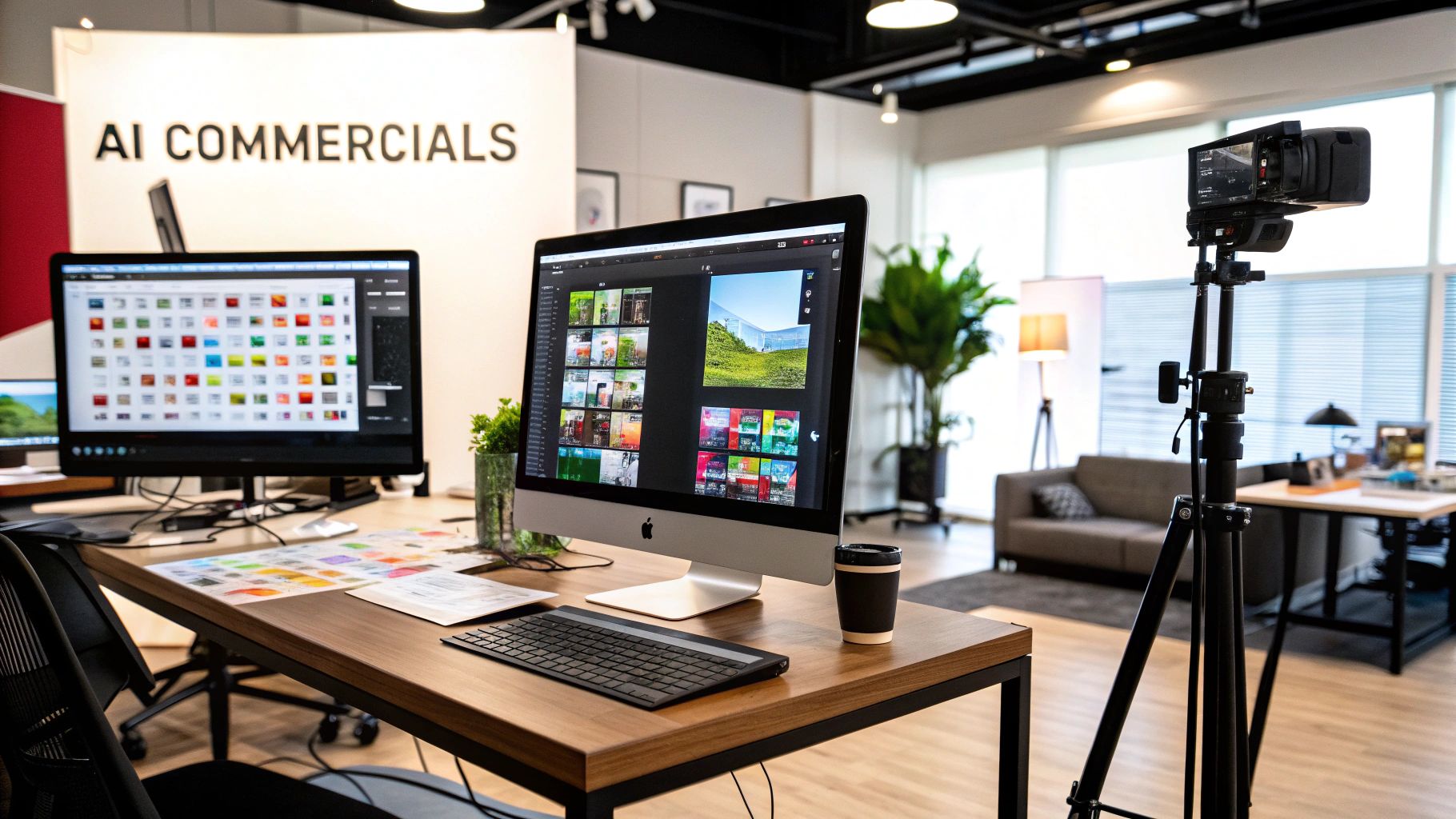
Think about having a full-blown creative team on standby 24/7—a director, a copywriter, and a visual effects artist—ready to turn your ideas into reality in an instant. That’s essentially the power AI brings to advertising. What once felt like a futuristic dream is now a real-world advantage for businesses of every size.
This shift is radically changing the speed, cost, and personalization of creating ads. Brands can now whip up dozens of different ad concepts to see what sticks, speak directly to niche audiences with tailor-made messaging, and launch campaigns with a speed that was once unimaginable.
A Shift From Months to Minutes
Remember the old way of making a commercial? It was a massive undertaking. You had film crews, actors, location scouts, and endless hours of post-production. It was slow and incredibly expensive.
An AI-driven workflow throws that old model out the window. It collapses all those steps into a simple, digital process. Instead of managing a huge team, a single marketer can now direct an AI with a few text prompts. It's a game-changer.
This new approach delivers some serious perks:
- Radical Speed: You can generate a whole suite of ad variations for A/B testing in a single afternoon.
- Cost Efficiency: Say goodbye to the massive overhead costs of physical production.
- Creative Freedom: Want to try a weird, bold, or unconventional idea? Go for it. There's virtually no financial risk.
More Than Just Automation
It’s easy to think of AI as just a robot doing what it's told, but that's a huge misconception. In advertising, AI acts more like a creative partner. It can generate fresh concepts that a human team might have never thought of by analyzing massive amounts of consumer data to suggest the visuals, copy, and stories most likely to connect with a specific audience.
This isn't about replacing human creativity; it's about amplifying it. AI handles the technical grind, freeing up marketers to focus on the big picture: strategy, brand voice, and crafting a message that truly resonates with people.
In this guide, we'll pull back the curtain on the technology driving this change, exploring the real-world benefits and best practices. We'll also look at how platforms like ViewPrinter are making these powerful tools accessible to everyone, defining what is quickly becoming the new standard in advertising. To see how modern agencies are adapting to this new landscape, check out a team like Vertically Media.
Let's dive in. This is your roadmap to navigating—and winning—in this new era.
How AI Crafts Commercials From Prompts to Production
Making a commercial used to be a massive undertaking with multiple teams, long shoots, and complicated edits. AI has completely changed the game. The entire process is now a fluid, digital workflow where specialized AI systems work together to bring an idea to life. Think of it less like a traditional film set and more like a symphony orchestra, where each instrument plays its part to create a cohesive masterpiece.
It all starts with a simple text prompt. This isn't a full script or a storyboard; it's the core creative instruction that guides everything else. It’s the director's initial vision, written down for the AI to understand and execute.
The Digital Director: Text-to-Video Models
At the very heart of AI generated commercials are text-to-video models. These are your digital directors and cinematographers, all rolled into one. You give them a descriptive prompt, and they get to work translating your words into moving images.
For instance, you might type: "A high-energy, 15-second commercial for 'Morning Rise Coffee.' Show a sun-drenched modern kitchen, a steaming mug of coffee on a marble countertop, and quick cuts of a person smiling and feeling energized. Cinematic, warm lighting."
The AI breaks this down instantly. It identifies the setting (kitchen), the product (coffee), the action (steaming, smiling), and the overall vibe (energized, cinematic). Then, it digs into its massive library of visual data to build a scene from scratch that perfectly matches your description.
The real magic here is the AI's knack for understanding abstract concepts. It doesn't just know what a "kitchen" is; it grasps the feeling of "high-energy" and "warm lighting," interpreting emotion and style just like a human director would.
This infographic gives you a bird's-eye view of how it all comes together.
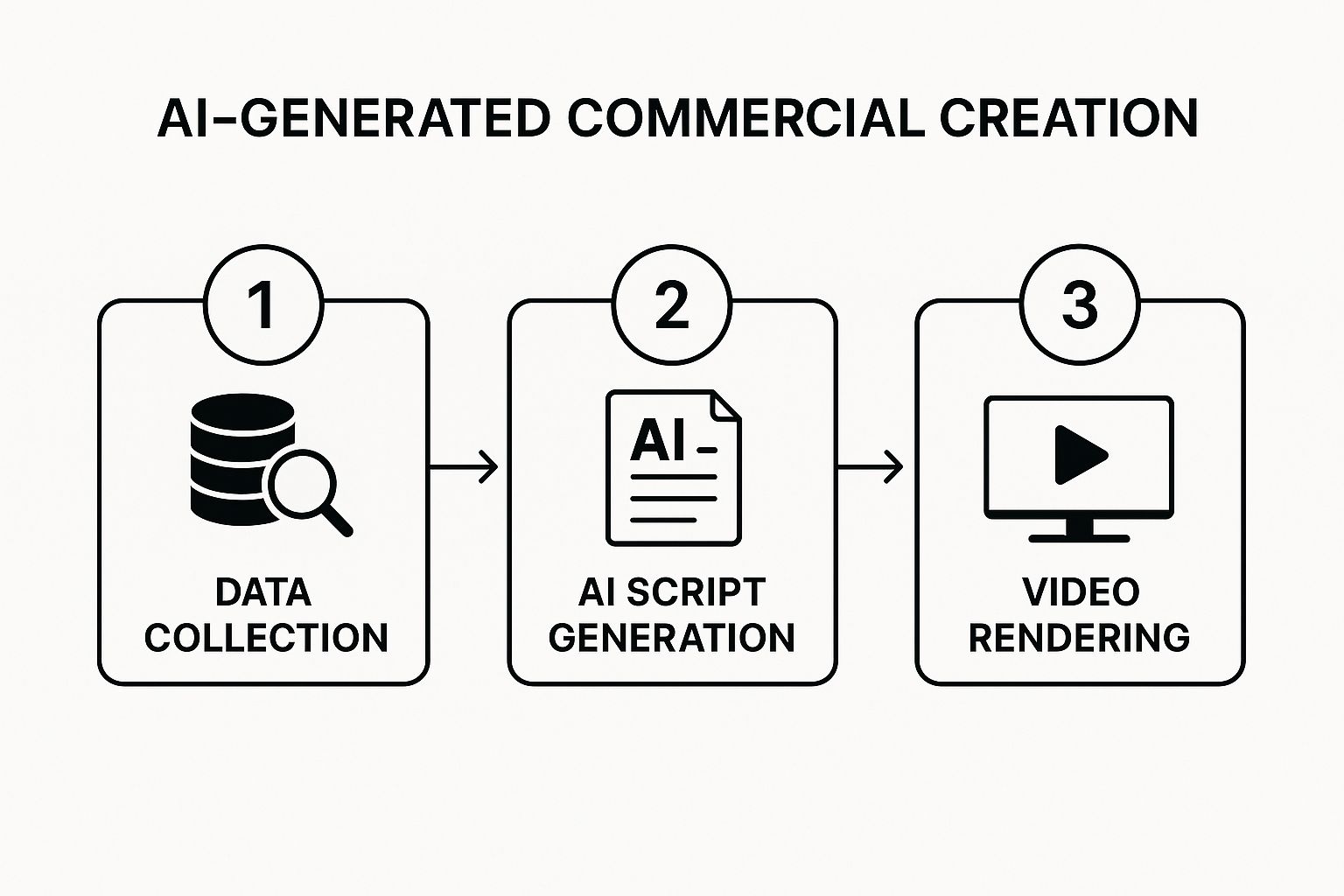
As you can see, the journey from a simple idea to a final, rendered video is surprisingly structured, yet incredibly fast.
Crafting the Message with AI Scriptwriting
While one AI is busy creating the visuals, another is working on the script. AI scriptwriters have been trained on millions of ads, so they know what kind of copy works. They understand the rhythm, tone, and persuasive language that gets people to act.
Let's stick with our coffee brand. The goal is a short, punchy script. A marketer might feed the AI these details:
- Product: Morning Rise Coffee (eco-friendly, organic)
- Target Audience: Young professionals, health-conscious
- Key Message: Start your day with clean, sustainable energy.
- Tone: Upbeat, inspiring, and concise.
Almost immediately, the AI will spit out several options. One might be: "(Scene opens on a beautiful sunrise) Narrator: Don't just wake up. Rise up. (Cut to steaming coffee) With Morning Rise, the world’s most sustainable coffee. (Person smiles, looking refreshed) Your day, powered by nature." This allows you to test different angles in seconds. If you want to see how the pros structure their copy, this advertising script example is a great resource that breaks it down step-by-step.
Giving the Commercial a Voice: AI Synthesis
Every great commercial needs a voice, and that's where AI voice synthesis steps in. We're not talking about the robotic, monotone voices from a decade ago. Today's AI can generate stunningly human-like narration in countless styles, accents, and emotional tones.
You can get incredibly specific, asking for "a warm, trustworthy female voice, mid-30s, with a calm and inspiring tone." The AI then generates the audio for your script, timed perfectly to the video. This completely removes the need to hire voice actors or book studio time. Best of all, if you change your mind and want a more energetic read, you can get a new voiceover with a single click.
Putting It All Together: The Final Edit
The last step is to bring all these elements together—the video clips, the script, and the voiceover—into one polished commercial. This is where a platform like ViewPrinter really shines, acting as the control room where all the AI-generated assets are assembled.
Here’s a quick look at the workflow:
- Visual Generation: The text-to-video AI creates the clips based on your prompts.
- Audio Production: The AI writes the copy and the voice synthesizer records the narration.
- Assembly and Timing: You arrange the clips, lay down the voiceover, and add background music or sound effects.
For our 15-second "Morning Rise Coffee" ad, this whole process is unbelievably quick. The AI generates the visuals, the scriptwriter nails the tagline, and the voice AI delivers a perfect narration. A marketer can pull it all together, test a few music tracks, and have a broadcast-ready commercial in less than an hour. It’s this seamless collaboration between different AI systems that makes modern ad creation so incredibly powerful.
The Business Case For AI in Ad Creation
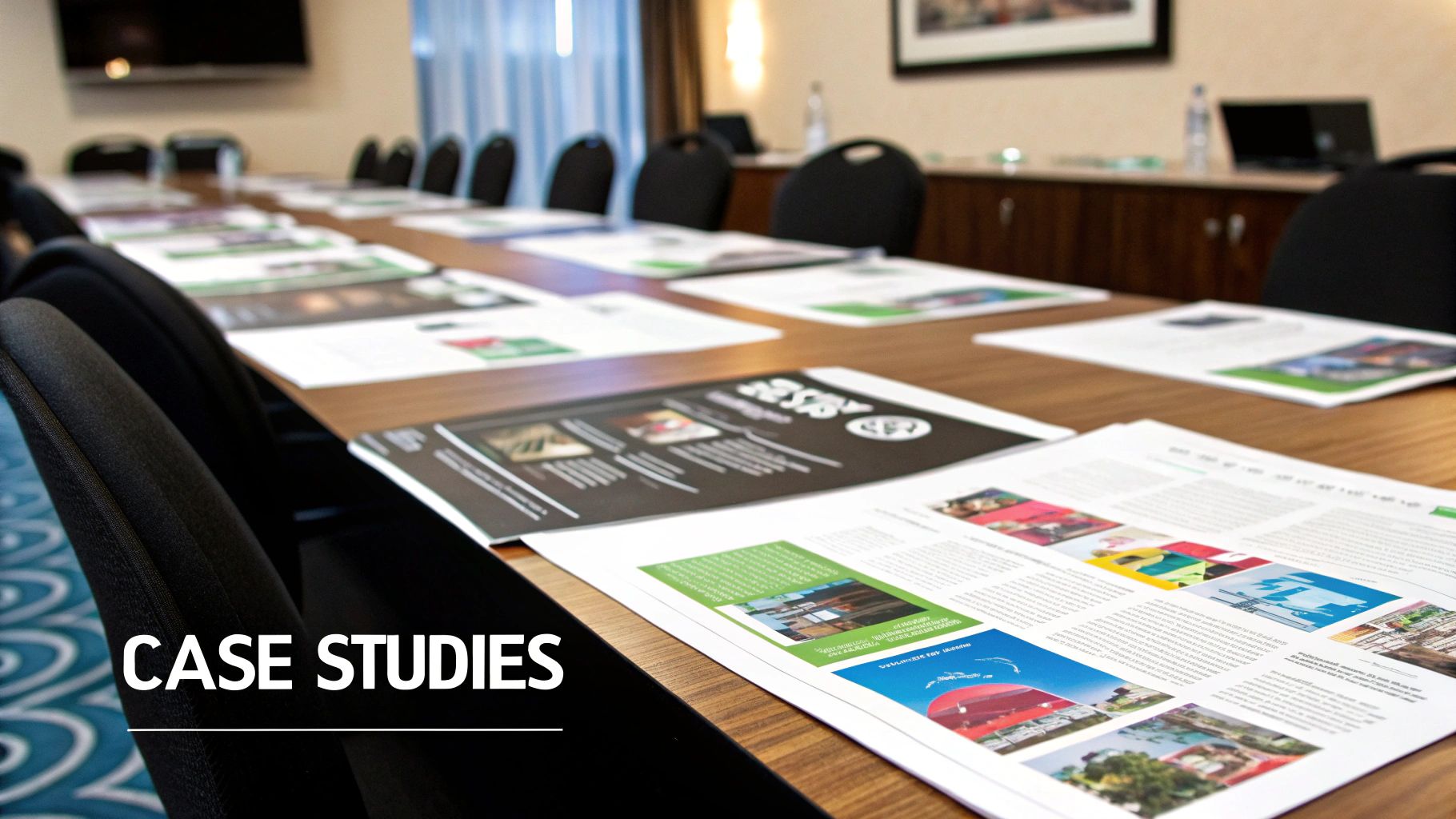
While the tech behind AI-generated commercials is undeniably cool, the real question for any business is always the same: what's the bottom line? Once you get past the novelty, the practical perks of using AI in ad creation are huge. We're talking direct impacts on speed, cost, and how well your campaigns actually perform.
This isn't just about small tweaks or minor upgrades. It’s a fundamental change in how brands can create, compete, and connect with their audience.
Unprecedented Production Speed
The most obvious win is just how fast everything becomes. In the old world, getting a single commercial made could take weeks, sometimes even months. With AI, that timeline gets crushed down to hours or, in some cases, minutes.
Think about it. You need to launch a last-minute flash sale for the weekend. Instead of a mad scramble and a massive bill, a marketer can spin up a dozen high-quality video ad variations in a single afternoon. This kind of speed means you can jump on market trends or respond to a competitor's move almost instantly—something that was pure fantasy with traditional production.
This agility opens up entirely new strategies. You can create a culture of constant experimentation, A/B testing messages, visuals, and calls-to-action to see what truly clicks with your audience. To get a better handle on this, check out our guide on AI ad creatives.
Drastic Cost Reduction
Let’s be honest: traditional video production is expensive. Between location scouting, hiring actors, renting gear, and paying a post-production crew, a single 30-second spot can easily cost tens of thousands of dollars. It’s a massive barrier that has kept smaller businesses on the sidelines of premium video advertising for years.
AI tools completely change the economics. They tear down that barrier by slashing costs. There are no film crews to hire, no sets to build, and no travel fees. The whole process is digital, which can reduce your overhead by an order of magnitude.
To get a clearer picture of just how different these two worlds are, let's break it down.
Traditional vs AI Commercial Production
| Metric | Traditional Production | AI-Generated Production | | :--- | :--- | :--- | | Timeline | 4-12 Weeks | 1-3 Days | | Cost | $15,000 - $100,000+ | $100 - $1,500 | | Revisions | Slow & Expensive | Fast & Inexpensive | | Variations | Extremely Limited | Virtually Unlimited | | Scalability | Low (Resource Intensive) | High (Software Driven) |
The table really says it all. The old way is a high-stakes, one-shot bet. The new way is about continuous, affordable, and scalable creation.
Hyper-Personalization at Scale
Here’s where things get really powerful. AI lets you create deeply personalized content for different segments of your audience without your costs spiraling out of control. With a traditional shoot, making five unique ads for five customer profiles would mean five separate, costly productions.
With AI, you can take one core idea and instantly morph it into countless variations. You can swap out protagonists, highlight different product features, or tweak the messaging to hit just the right note for specific demographics.
- A fitness brand could create one ad for marathon runners and another for yoga lovers, all from the same starting point.
- An e-commerce store could show different products to men and women, or to first-time visitors versus loyal customers.
This is hyper-personalization at scale, a strategy that used to be reserved for corporations with massive budgets. Now, any brand can speak directly to the different needs and interests of its customers, building stronger connections and driving up conversion rates.
Data-Driven Creative Optimization
Finally, AI closes the loop on the creative process. It doesn’t just make the ads; it helps you make them better based on what the data says. By analyzing metrics like click-through rates and conversions, AI can spot patterns and suggest specific tweaks to your creative.
This turns ad creation from a process of guesswork and gut feelings into a more scientific method. The results speak for themselves. Studies have shown that AI-optimized creatives can achieve up to twice the click-through rates (CTR) of their human-designed counterparts.
Some brands have even seen a 50% lift in Return on Ad Spend (ROAS) after weaving AI into their workflow. It's a clear line from smarter creative to better business results. This cycle of continuous optimization ensures your campaigns don't just launch; they learn, adapt, and get more effective over time.
The Money Behind the Movement
The buzz around AI-generated commercials isn't just about cool new creative tools; it’s about a massive economic tidal wave that’s reshaping the entire advertising industry. For advertisers, this means more powerful tools, fiercer competition, and—surprisingly—more opportunities for businesses of every size.
To really get what's happening, you have to look at the financial scale of AI in marketing. This isn't some niche trend propped up by a few startups. We're talking about a global movement backed by billions in investment, which signals a fundamental change in how ad dollars will be spent for years to come.
The AI Ad Market is Exploding
The numbers tell a pretty stunning story of growth. The AI marketing sector, which is the engine powering AI commercial production, is in the middle of a massive expansion.
The industry is on a rocket ship trajectory. Valued at roughly $47.32 billion in 2025, the AI marketing space is set to grow at a compound annual growth rate (CAGR) of 36.6%, blowing past $107.5 billion by 2028. If you zoom in on generative AI—the specific tech that creates these commercials—the numbers get even wilder. That market is estimated at $62.75 billion in 2025 and is projected to hit an incredible $356.05 billion by 2030, with a CAGR of 41.52%. You can dig deeper into these marketing statistics on seo.com.
This kind of growth doesn't happen by accident. It’s a direct result of the incredible value AI delivers, from making things faster to unlocking creative ideas we couldn't reach before.
These aren't just numbers on a chart. They represent a huge shift of money and resources toward AI-powered advertising. Trying to ignore this momentum is like trying to paddle a canoe against a tsunami.
What This Means for Your Business
All this investment pouring into AI advertising isn't just happening in a vacuum; it directly impacts your business and changes the competitive landscape under your feet.
Here’s what this financial shift really means for advertisers:
- Better Tools for Everyone: Massive investment leads to intense competition among AI developers. That pressure brings prices down and makes high-end video production tools accessible to small and medium-sized businesses that were previously locked out.
- An Arms Race for Attention: As more of your competitors start using AI, the quality bar for ads will keep rising. If you don't keep up, you risk getting drowned out by rivals who can create better, more targeted ads in a fraction of the time.
- The Skills You Need Are Changing: The focus is shifting from hands-on production work to big-picture strategy. Marketers now need to get good at guiding AI tools, making sense of the data, and refining creative ideas, not managing camera crews.
At the end of the day, the market data makes it clear: using AI in your advertising is no longer a "maybe someday" option. It's a critical move for survival and growth. This isn't just about adding a new piece of software; it's about making a strategic bet to stay ahead in a world that's changing fast. The time to get on board is now.
Alright, having a powerful AI tool is one thing. But getting it to make commercials that actually connect with people and get results? That’s a whole different ballgame.
Creating effective AI generated commercials isn't about just hitting a button. It's more like a partnership, where your human expertise guides the machine's incredible efficiency.
Think of your AI model as a brilliant but very literal apprentice. It can pull off complex tasks at lightning speed, but it needs crystal-clear direction to create something that feels true to your brand. Without that guidance, you'll end up with generic content that completely misses your unique voice.
The goal here is to move past simple content generation and start crafting compelling stories. This means you’ll need to get good at directing, refining, and making sure the quality is top-notch.
Master Your Prompts
The single most important skill in this new world is prompt engineering. Your prompts are basically the creative briefs you hand to your AI co-pilot. If they’re vague, you’ll get vague visuals back. But if you're descriptive and detailed, you'll get specific, on-brand results.
Don’t just write, "a car driving on a road." Be the director.
Instead, try something like: "A cinematic shot of a sleek, black electric car driving on a winding coastal highway at sunset. The lighting is warm and golden, reflecting off the car's surface. The mood is aspirational and serene." See the difference? The more detail you feed the AI, the closer it gets to what's in your head.
Here are a few tips to level up your prompts:
- Be Specific: Mention camera angles ("drone shot," "close-up"), lighting ("soft morning light," "dramatic neon glow"), and the emotional tone you're after ("joyful," "adventurous").
- Use Adjectives: Words like "luxurious," "rustic," "minimalist," or "vibrant" are your best friends. They give the AI essential style cues.
- Iterate and Refine: Your first prompt is almost never the final one. Tweak your words, add negative prompts to get rid of things you don't want, and keep generating until it’s perfect.
Maintain Brand Consistency
One of the trickiest parts of using AI is making sure the final product actually fits your brand. An AI model has no idea what your color palette, fonts, or brand voice are. It's on you to set those boundaries.
A great way to keep your AI generated commercials consistent is to create a "brand kit" for your prompts. This should be a collection of key descriptors that define your visual style, target audience, and overall vibe. For example, a brand aiming for Gen Z might always include terms like "authentic," "user-generated feel," and "vibrant colors" in its prompts.
Think of it as creating a brand bible for your AI. By consistently using the same core descriptors and visual cues, you train the AI—and your team—to produce content that always feels like it comes from you.
This kind of systematic approach stops your ads from feeling random and helps you build a cohesive brand experience across every campaign. Digging into different ways to maintain this consistency is a huge part of mastering AI video ads.
Always Keep a Human in the Loop
AI is an amazing tool for getting things done, but human oversight is completely non-negotiable when it comes to strategy and quality. The "human-in-the-loop" model is the gold standard for a reason. It just means that a real person is always there to guide, review, and give the final thumbs-up.
So what does the human do?
- Strategic Direction: You're the one defining the campaign goals, the core message, and the audience before a single pixel is generated.
- Creative Refinement: You’ll review the AI’s scripts and visuals to make sure they hit the right emotional notes and line up with the campaign's goals.
- Final Quality Assurance: Before anything goes live, you check for weird visual glitches, awkward phrasing, or anything that's just plain wrong.
To make sure your AI ads are both effective and compliant, you absolutely need to have solid key ad QA processes and checklists in place. This final check is what separates a polished, professional ad from one that feels a little off. When you blend AI’s speed with human judgment, you truly get the best of both worlds.
Answering Your Questions About AI Commercials
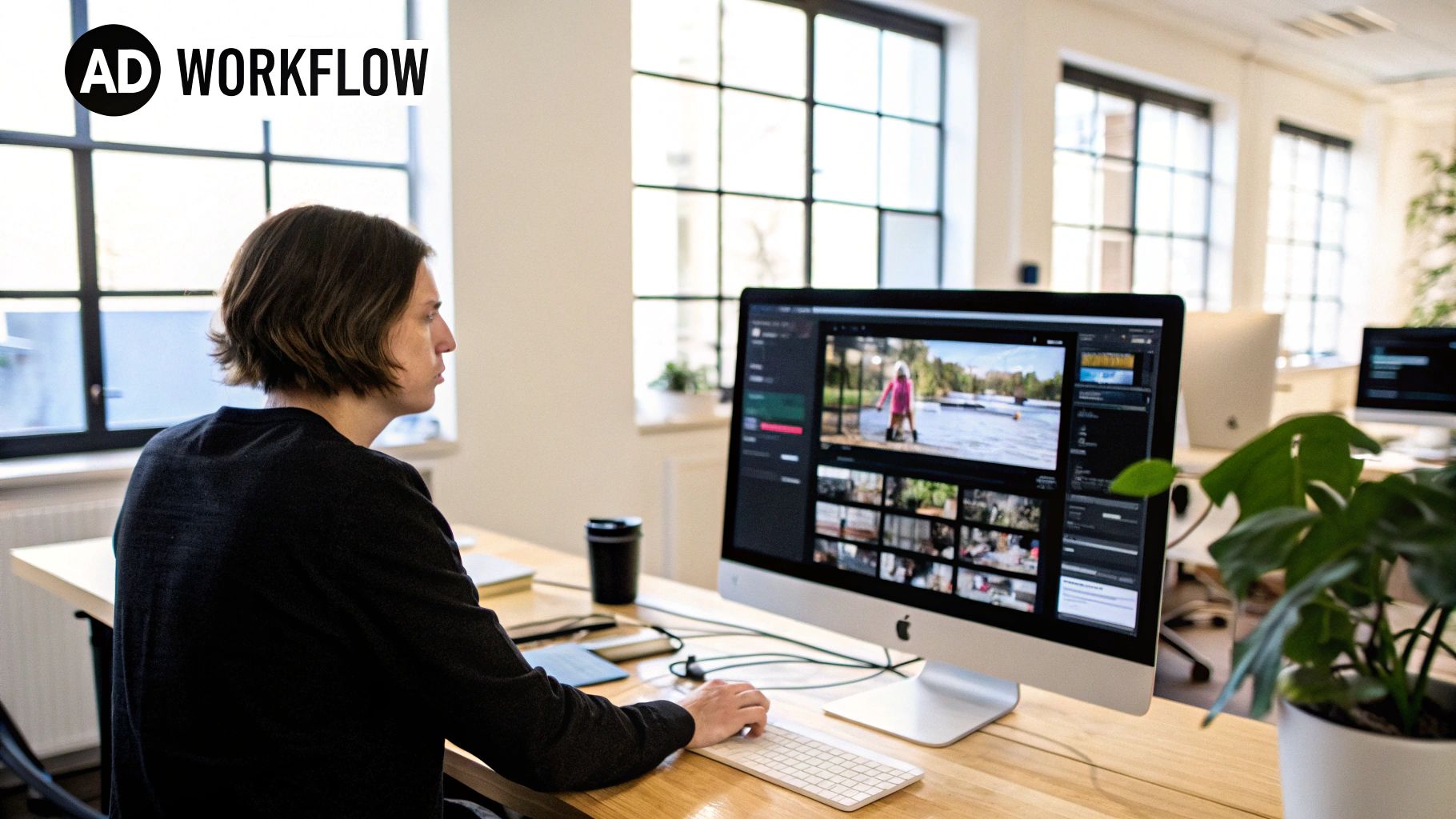
Like any exciting new tool, the idea of AI-generated commercials kicks up a lot of questions. People wonder about creativity, the current tech limits, and how it all works in the real world. Let's dig into some of the most common questions to clear things up.
Can AI Truly Replace Human Creativity?
The short answer? Not a chance. Think of AI as an incredibly fast and talented assistant, not the director. It can brainstorm a thousand ideas in a minute and handle the technical heavy lifting, but it doesn't have your strategic vision or your gut feeling for what connects with people.
The magic happens when you pair AI’s raw power with a human touch. You still need a person to steer the ship, make sure the final cut feels true to the brand, and add that little bit of nuance that makes an ad memorable.
AI does the heavy lifting, but humans provide the strategy and the soul. The best results come from this powerful partnership, where machine efficiency meets human creativity to create something truly special.
Ultimately, AI isn't here to take your job. It's here to take the tedious parts of your job, freeing you up to focus on the big-picture ideas that really matter.
What Are the Biggest Limitations of AI Commercials Today?
The technology is getting better at a dizzying pace, but it's not perfect. You still have to keep an eye out for a few quirks. The most common one is weird visual glitches—think of a person with six fingers or a coffee cup that floats in a way that just feels… off.
AI can also default to generic, cookie-cutter content if you don't give it very specific instructions. Without your unique direction, it can easily create an ad that looks good but has zero personality.
Here are the main bumps in the road right now:
- Visual Inconsistencies: Little goofs and artifacts in the video clips that a human needs to catch and fix.
- Risk of Generic Output: Without detailed, creative prompts, the results can feel bland and forgettable.
- Legal and Ethical Gray Areas: The rules around copyright and the data used for training AI models are still being written.
But these hurdles are shrinking every day. The real challenge for marketers is learning how to work with these tools, playing to their strengths while sidestepping their weaknesses.
How Can a Small Business Start Using AI for Commercials?
Jumping in is much easier than you’d think. You don't need a Hollywood budget. The best first step is to explore some of the user-friendly AI video platforms out there—many offer free trials or super affordable starter plans.
Don’t try to create a Super Bowl ad on your first go. Start small. Try making a quick, simple video for a social media post. Focus on writing clear, descriptive prompts that get your main message across.
The name of the game is experimentation. Play around, see what kind of results you get, and learn how to translate your brand's voice into this powerful new format.
Ready to create compelling, high-converting social media ads in minutes? ViewPrinter provides an all-in-one platform to generate, edit, and schedule viral content using advanced AI. Start creating with ViewPrinter today!